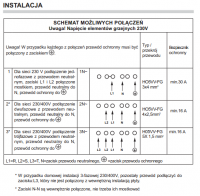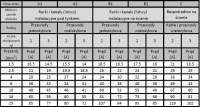Perhaps a washing machine and dryer simulator would be an ordinary kitchen. In them - depending on the type and manufacturer - all connection combinations are used.
This is illustrated by the following drawing taken from the manufacturer of the device - an induction hob:
 Podłącze..e.png Download(85.98 kB)
Podłącze..e.png Download(85.98 kB) Another example is a gas cooker with an electric oven or a cooker with a ceramic hob and electric oven - the connection diagram is identical.
 podłączen.. 2.png Download(84.61 kB)
podłączen.. 2.png Download(84.61 kB) "The kitchen is factory-adjusted to be supplied with three-phase alternating current (400V 3N ~ 50Hz). The rated voltage of the kitchen heating elements is 230 V."
In fact, the manufacturer stipulates that the board is three-phase 400 V, but the heaters are 230 V (he gives contradictory information). In fact, these are 230 V devices, but powered from three, two or one phase and not phase-to-phase. Information about 400 V can be misinterpreted (and probably it happened more than once)!
Why am I giving you an example of a kitchen? Well, because kitchens are available in variants: combined in one device and separate as two devices.
The same is the situation here with the two appliances in the form of a washing machine and a dryer.
The issue here is that each device should have a separate power cord - this is what the regulations say and here it is consent.
On the other hand, to the question asked from the technical point of view, the answer in the above context may be that a washing machine and dryer on one four-core power cable (but two phases) is an identical technical example as a kitchen with a ceramic hob and an electric oven powered from two phases (one supplies the hob and the other an oven). Other combinations also come into play here.
Technically there is no difference. Both the hob and the oven use a common N conductor (the manufacturer has not separated the hob and oven circuits and there are no separate N conductors, but such a situation will occur with two separate devices, e.g. an oven and an electric hob). Thus, according to the regulations, they do not have separate power circuits. However, physically it is one device (two functional devices in one housing), which makes such a hybrid compliant.
Therefore, the answer to the author's question whether, when it is as there is any problem with operation in the technical sense, it should be answered that it will work. The main thing to pay attention to is the cross-section of the cable cores in relation to the power of the devices, which in total is 4400 W.
It is worth paying attention to the above diagrams, how the cable cross-section changes depending on the combination of heater connections. The manufacturer of a kitchen with a ceramic hob and electric oven allows a single-phase power supply, but then the cable cores are to be 4 mm2. The maximum power of the device is 10 kW.
Regards!





